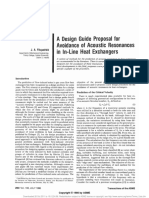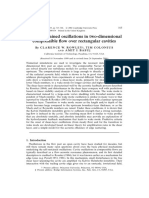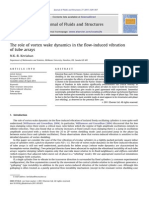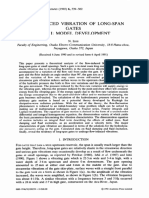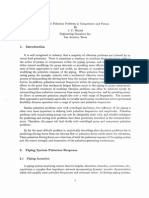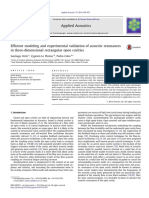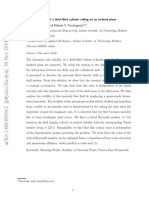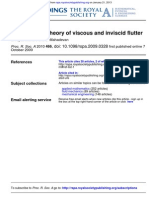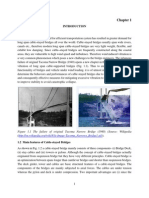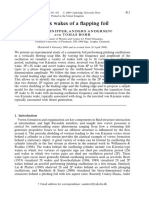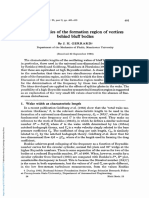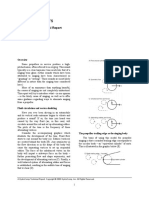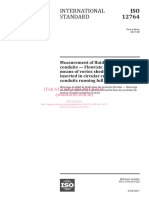Review—Self-Sustaining Oscillations of Flow Past Cavities
Uploaded by
Илья ОвиновReview—Self-Sustaining Oscillations of Flow Past Cavities
Uploaded by
Илья ОвиновReview—Self-Sustaining Oscillations of Flow
D. ROCKWELL
Professor of Mechanical Engineering,
Past Cav ities
Department of Mechanical
Engineering and Mechanics, Unstable flow past cavities is grouped into fluid-dynamic, fluid-resonant, and fluid-
Lehigh University, elastic categories. Fluid-dynamic oscillations are attributable to instability of the cavity
Bethlehem, Penn.
shear layer and are enhanced through a feedback mechanism. Fluid-resonant oscilla-
tions are governed by resonance conditions associated with compressibility or free-
E. NAUDASCHER surface wave phenomena. Fluid-elastic oscillations are primarily controlled by the
elastic displacements of a solid boundary. Experimental information and theoretical
Professor and Director, models for the frequencies and amplitudes of each of these categories of oscillations as
Institute of Hydromechanics,
University of Karlsruhe, well as a combination of them are discussed in detail. Effects of arrangements of
Karlsruhe, West Germany cavities in groups and variations in cavity shape (rectangular, circular, triangular,
whistle-type, Helmholtz-type) are reviewed. Means of attenuation of oscillations via
geometrical modifications and mass addition are summarized. Finally, the effects of
cavity oscillations on the time-mean cavity pressure, drag, and shear-laijer charac-
teristics are discussed.
Introduction matrix. The first column of this matrix illustrates the basic
cavity geometry, whereas the second column depicts some of the
The unsteady flow in and near cavity-type geometries, which variations of this basic geometry which are found in practice.
belongs to a basic class of flows susceptible to self-sustaining Each of the fluid-dynamic applications (first row) exhibits a
oscillations, occurs in a variety of applications such as slotted- frequency of oscillation which can be traced to the selective
wall wind and water tunnels [1, 2, 3]1 and slotted-flumes [4], amplification of vorticity fluctuations in the cavity shear-layer
bellows-type pipe geometries [5, 6], high-head gates [7] and gate and a feedback condition due to the upstream propagation of
slots [8], and aircraft components [9, 10, 11, 12]. These cavity- disturbances which is enhanced by presence of the cavity edge
type oscillations are undesirable from the perspectives of induce- (reference [13]). Applications falling within the fluid-resonant
ment of structural vibration and fatigue, generation of noise, category (second row) are influenced by compressibility wave or
and drastic increases in mean drag on the body which houses the free-surface wave effects. Fluid-elastic oscillations (third row)
cavity. are dependent upon the elastic, inertial, and damping properties
Despite the diversity of types of cavity oscillations, several of the structural system and require corresponding characteristics
common features can be observed. This suggests that a general for complete description. Of course, in practice, oscillations can
framework for describing cavity-type oscillations may be es- be controlled by mechanisms which are simultaneously fluid-
tablished. In this general framework, or matrix, the terminology dynamic, fluid-resonant, and fluid-elastic in nature. But even
of Naudascher [13] is employed. Self-sustaining (or self-con- then, the method of synthesis illustrated in Fig. 1 will facilitate
trolled) oscillations are categorized into three groups: (a) fluid- detailed analysis of the predominant features of the oscillations.
dynamic, where oscillations arise from inherent instability of
the flow; (b) fluid-resonant, where oscillations are influenced by
resonant wave effects (standing waves); and (c) fluid-elastic, Fluid-Dynamic Oscillations
where oscillations are coupled with the motion of a solid bound-
Purely fluid-dynamic oscillations (as opposed to fluid-resonant
ary. In Fig. 1, these categories are represented in three rows of a
oscillations) can occur if the ratio of the cavity length to the
acoustic wave-length is very small, and if, in the case of liquids,
no free surface wave effects are present. Since the primary
l u m b e r s in brackets designate References at end of paper.
mechanism for excitation of fluid-dynamic oscillations is the
amplification of unstable disturbances in the cavity shear layer
Contributed by the Fluids Engineering Division for publication in the [3, 7, 14], and the oscillation is strongly enhanced by the presence
JOURNAL OF FLUIDS ENGINEERING. Manuscript received by the Fluids En-
gineering Division, August, 1977. of the downstream edge of the cavity, this type of oscillation can
152 / Vol. 100, JUNE 1978 Copyright © 1978 by ASME Transactions of the ASME
Downloaded From: http://fluidsengineering.asmedigitalcollection.asme.org/ on 08/28/2013 Terms of Use: http://asme.org/terms
BASIC CAVITY VARIATIONS OF BASIC CAVITY
XS^^CT^-^^ 777777-777,
'77/77/777
AXISYMMETRIC EXTERNAL CAVITY-PERFORATED
CAVITY PLATE
V7ZTjS~r\T77>.
AXISYMMETRIC INTERNAL GATE WITH EXTENDED LIP
CAVITY
'7777777-/, •'777777-777777,
^"fEI
SHALLOW CAVITY CAVITY WITH EXTENSION
HELMHOLTZ RESONATOR
BRANCHED PIPE CIRCULAR CAVITY
CAVITY WITH
VIBRATING
VSg
« *mr
VIBRATING GATE VIBRATING BELLOWS VIBRATING F L A P
COMPONENT
Fig. 1 Matrix categorization of fluid-dynamic, fluid-resonant, and
fluid-elastic types of cavity oscillations
be expected to have some features in common with the jet-edge of large amplitude oscillations can be best described in terms of
type of oscillation involving impingement of a free jet upon an an effective feedback. This feedback, which is essentially the
edge [15, 16]. Unlike the cavity geometry, the jet-edge oscillation upstream propagation of disturbances, is enhanced by t h e
is not constrained by mass conservation within an adjacent presence of the downstream cavity edge. The pressure perturba-
closed volume. Yet the remaining fundamental features are very tions emanating from (or in the vicinity of) the downstream
similar, suggesting a similar analytical approach. cavity edge produce vorticity fluctuations near the sensitive
Two aspects of this fluid-dynamic excitation mechanism should shear layer origin, which in turn provide enhanced disturbances
be emphasized: the amplification conditions of shear-layer in- to be further amplified in the shear layer, and so on.
stability and the feedback condition. The selective amplifica- Fig. 2 illustrates the physically significant parameters for
tion characteristic of shear flow, which causes certain dis- fluid-dynamic oscillations: Re, do*/L, 6a/L, L/W. In a rigorous
turbances to be amplified more than others, is a necessary, b u t sense, specification of the turbulence characteristics in the y
not sufficient, condition for coherent oscillating flow to be direction (e.g., effective viscosity distribution) will be necessary
produced. An important additional condition for the generation to predict the instability characteristics of the spearated shear
'Nomenclatyre-
a — amplitude of free surface oscilla- tion due to shear layer in- S Strouhal number = fL/U
tion = half the height be- stability (Hz) U free stream velocity (m/s)
tween crest and trough of natural frequency of coupled wall friction velocity \/ra/p
wave (cm) system (Hz) (m/s)
b = width of channel (cm) resonant frequency of cavity cavity depth (cm)
c = speed of sound (m/s) corresponding to compressi-
w quantity evaluated at n t h mode
Ci = phase angle between waves and bility or free surface waves of oscillation
vortices in cavity (Hz) ( )o - parameter evaluated at x = 0
Cp/ = root mean square of fluctuating h = mean depth of free surface flow dimensionless frequency based
pressure coefficient between
0 =
(cm) on momentum thickness
frequencies f — elf and f + df I = intensity of sound (db) = 2irf8/U
= [(v\f)?/tt/2pUmm/W] k = mode number of fluid-resonant 6 boundary layer thickness (cm)
Cprms = root mean square of fluctuating (wave) oscillations = 1, 2, 3, 8* boundary layer displacement
pressure coefficient = {(p*) 2 / thickness (cm)
[l/2p£WP}ira L = length of rectangular cavity ratio of specific heats
D = cavity width in spanwise direc- y =
(cm) K = coupling coefficient
tion (cm) L* = length of whistle-type cavity pipe length in a reed-pipe reso-
I =
d = diameter of circular cross-sec- (cm) nator
tion cavity (cm) M = free stream Mach number = U/c kinematic viscosity (m 2 /s)
V =
e = offset of downstream cavity wall density (kg/m 8 )
mode number of fluid dynamic p =
(cm) (shear layer instability) os- T,„ = wall shear stress (N/m 2 )
/ = frequency (Hz) cillations = 1, 2, 3, . . . e = b o u n d a r y layer momentum
/(, = blade natural frequency (Hz) C,U = convective velocity of vortices thickness (cm)
/„ = frequency of organized oscilla- in shear layer (m/s) K = acoustic wavelength (cm)
Journal of Fluids Engineering JUNE 1978, Vol. 100 / 153
Downloaded From: http://fluidsengineering.asmedigitalcollection.asme.org/ on 08/28/2013 Terms of Use: http://asme.org/terms
2.0
u Ulxl
R. RJx)
/e 0 /e(x) pu'v'(x.y) „ ° ° So
8 lxl puv (x,y) 1.5 &_^8-J2_o2a-—as——o—. n = 3
u'v'(y)}0
0
a * q -Ink
I 8
o o o
9 ® * * » I f® @
) »_x
1.0
I
i^#f^ ® o • • © n=z
L •""
It 0.5
Fig. Z Definition of important geometrical and flow parameters for
unstable cavity flow
0 1 5 L/W 6
Fig. 4 Variation of organized-oscillation Strouhal number (S„ =
fnL/W) with cavity length (L/W) for fluid-dynamic oscillations in a two-
dimensional cavity. da*/W = 0.042, Oa/W = 0.025, Rejo^2.5 X 105 (data
from Ethembabaoglu [8]- dark points represent predominant mode;
TIT solid lines represent theory [14).
20-
0.6 x 103
...
0.5 -
. -~t —
e._ 1
Sfe,^^^^;
4
\&
MODE MODE 0.4 _
-
2 3 CAVITY OSCILLATIONS
10 8 A
*%iv
0 1.0 fL ^ 0.3
" U 2D
Fig. 3 Typical spectrum of pressure fluctuations measured on the NO CAVITY OSCILLATIONS
downstream cavity wall for the case of a turbulent boundary layer at i i i
separation (Ethembabaoglu [8]). Symbols A, O correspond to different 0.2
5 10 15 20 25
runs. h*IW = 0.042, 60/W = 0.025, Rejo ~ 2.5 X 10s, L/W = 3.6.
w/6 0
Fig. 5 Minimum dimensionless length for existence of fluid-dynamic
layer. To date, information on the propagation of disturbances cavity oscillations (Lm\/Rm%l5a versus cavity depth (W/a0) for axisym-
metric type cavity. Different data points correspond to different
in an initially turbulent free shear layer is lacking. In addition, body-nose shapes (see Fig. 1); boundary layer at separation main-
parameters for the spanwise geometry—i.e., the dimensionless tained laminar (Sarohia [25, 26]).
spanwise distance (D/L)—should be specified. However, little
experimental information is available which gives physical in-
sight into the possible influence of unsteady three-dimensionali- simultaneously. Fig. 4 depicts the variation of the Strouhal
ties. Such three-dimensional behavior could be enhanced by numbers at these peaks as a function of L/W for each of the three
finite cavity span. Possible coupling between these time-de- possible modes. Dark circles represent the Strouhal number with
pendent three-dimensionalities and the well recognized three- the predominant peak amplitude at a given L/W; as L/W in-
dimensionalities of the mean flow [17, 18] awaits investigation. creases, this predominant Strouhal number is seen to jump from
Studies of the sort carried out by Rockwell [19], Holdemann and the first to the second mode.
Foss [20], and Miksad [21] for jets and mixing layers are needed. In contrast to the turbulent boundary-layer study of Ethem-
Three-dimensionalities in the impingement region of the down- babaoglu, Sarohia [25] has taken measurements of mean and
stream cavity corner should have many features in common with fluctuating flow fields for axisymmetric type cavities (see Fig. 1),
those produced by other types of impinging flows, which have where the boundary layer at separation was laminar. The cavity
recently been summarized by Morkovin [22]. In this review, the depth (IF) had insignificant effect on the oscillations, except
quasi-two-dimensional nature of the flow, which governs the when the depth was of the same order as the boundary-layer
overall nature of the oscillation, will receive primary attention. thickness. For this small cavity depth, the laminar shear layer
Extensive data of Ethembabaoglu [8], taken in a water tunnel was stabilized and transition to turbulent flow was delayed in
in the absence of cavitation (see Fig. 2 for cavity geometry), comparison to the case of a free shear layer not flowing over a
have provided insight into several aspects of fluid-dynamic cavity cavity. In addition, Sarohia characterized a minimum cavity
oscillations. The boundary layer at separation was turbulent, length below which cavity oscillations did not_occur. The cor-
yet the spectrum of the pressure fluctuations measured on the responding minimum-length parameter (Lm\/Ren/do) is plotted
downstream cavity wall had an organized character as illustrated against cavity depth (W/So) in Fig. 5. Strong variations of
in Fig. 3. The two peaks of this spectrum correspond to organized minimum length occur for W/So smaller than about one. Pre-
fluctuations. In accordance with an analysis of cavity oscilla- diction of this minimum length can probably be accomplished
tions, given below, these peaks are designated as the second and using a technique similar to that of Woolley and Karamcheti
third modes (ra = 2, 3) of the periodic oscillation. This or- [2] which accommodates low values of Reynolds number (Re)
ganized character of the flow reinforces recent experiments deal- where amplification and damping of shear layer disturbances is
ing with the coherent structure of free shear layers in the absence important. According to their criterion, the integrated amplifica-
of cavities [23, 24]. Most of Ethembabaoglu's spectra show one tion along the mouth of the cavity must be positive for an oscilla-
mode having a predominant peak, although two modes can exist tion to occur.
154 / Vol. 100, JUNE 1978 Transactions of the ASME
Downloaded From: http://fluidsengineering.asmedigitalcollection.asme.org/ on 08/28/2013 Terms of Use: http://asme.org/terms
The special cavity geometry of a gate with an extended lip dicting the predominant mode (n = 1, 2, or 3) of oscillation.
(see Fig. 1) has received considerable attention. As shown by Comparison of this model with experiment shows reasonable
Martin, Nandascher, and Padmanabhan [7], such cavity oscilla- good agreement for eight different frequencies, with maxi-
tions are traceable to disturbance amplification in the finite- mum deviation being about thirty percent. This comparison
thickness shear-layer acting in harmony with a feedback condi- was made for unstable laminar shear layers, as contrasted with
tion. The flow past such a gate has many features in common the turbulent shear-layer experiments of Ethembabaoglu. Un-
with the aforementioned flow past a basic rectangular cavity: fortunately, the data of Ethembabaoglu do not include 6(x)
simultaneous existence of two modes of oscillation, predominance measurements, so a direct comparison of Sarohia's model with
of one of these modes, and superposition of these organized modes the above models cannot, be accurately carried out. Detailed
on a background turbulent spectrum. time-mean and time-dependent data spanning the laminar and
Prediction models for the dimensionless frequencies of oscilla- turbulent regimes are needed before a critical comparison of
tion (S) of the cavity configuration have been formulated by these models can be undertaken.
King, Boyle, and Ogle [3], Martin, Naudascher, and Padmanab- All of the aforementioned theoretical models account neither
haii [7], Rockwell [14], and Sarohia [26], These models can for details of the time-dependent flow-impingement region, which
be classified according to the criterion for oscillation to occur. will be important in predicting amplitude of oscillations, nor
Models of [3, 7, 14] all use a "feedback" phase-angle condition. for possible resonant wave effects, which become important for
The perturbation of the volume bounded by the shear layer and compressible flow or for certain flows with free-surface waves.
cavity walls must be 7r out of phase with the displacement In addition, all of the above prediction methods employ inviscid
perturbation at the shear layer origin if an oscillation is to occur. approximations for the unstable disturbance growth in the shear
In contrast to the models of [3, 7, 14], the model of [26] uses a layer. According to the model of Woolley and Karamcheti [16],
different criterion for an oscillation to occur. The integrated the disturbance is damped by viscous effects after it has reached
amplification of the disturbance is maximum for the frequency some maximum integrated amplification at a certain distance
at which an oscillation is self-sustaining; however, it is also downstream. This influence of viscous effects is important in
necessary to prescribe a phase difference between separation and predicting the velocity at which the onset of oscillation occurs.
impingement in determining the frequency selected by the cavity. None of the above analyses of unstable cavity oscillations in-
Another way of classifying the models of [3, 7, 14, 26] is the cludes consideration of the recirculating-flow field within the
manner in which the shear-layer stability is treated. The model cavity. The computer model of Hardin and Mason [10] uses
of King, Boyle, and Ogle is limited to the special case for which discrete vortices to simulate the overall flow field behavior, in-
the cavity shear layer is maintained very thin (e.g., by use of a cluding the recirculating flow. Although the frequencies were
perforated plate as shown in Fig. 1). With this constraint, the not predicted in this investigation, this type of flow field model
theory for infinitesimally thin free shear-layers can be employed. can, in principle, yield self-sustaining oscillation frequencies as
The model advanced by Martin, Naudascher, and Padmanabhan, discussed by Clements and Maull [27].
has greater practical implication because it accounts for the in-
stability characteristics of a shear layer of finite thickness and
uses a global value of shear-layer momentum thickness. The
Fluid-Resonant Cavity Oscillations
models of Rockwell and Sarohia accommodate the streamwise Self-sustaining cavity oscillations which are strongly coupled
growth of the shear layer momentum thickness and the con- with resonant wave effects within the cavity may be classified
sequent streamwise variations of wave number (ar) and amplifica- as fluid-resonant oscillations. For this class of oscillations, the
tion factor ( — a,-) of the disturbance. According to Rockwell, frequencies are sufficiently high that the corresponding acoustic
the following equation must be satisfied for a self-sustaining os- wavelength (or wavelength of gravity waves in cases of open-
cillation to occur: channel flow) is of the same order of magnitude or smaller than
the cavity characteristic length, L or W? (For the ideal case of
(x)dx an organ pipe resonator, resonance is possible if Xa < 2L or
Jo yix dx = 0 \ „ < iL, depending on the pipe end conditions.) If the cavity
Jo 0 length to width ratio {L/W) is sufficiently large, longitudinal
standing waves may exist and the cavity is termed a shallow
The above equation is most easily solved by detemining ar(x)
cavity. Conversely, if L/W is sufficiently small, transverse waves
and — ai(x) for a given frequency, then finding values of Lif
may be present and the cavity is denoted a deep cavity. Al-
L2, . . . corresponding to modes n — 1, 2, . . . (see [14] for details).
though the values of L/W which define shallow and deep cavities
Comparison of this model with the data of Ethembabaoglu is
have not been precisely established, Heller, Holmes, and Covert
given in Fig. 4. If a,(x) and — ai(x) are treated as constant,
[28] note that shallow cavity behavior tends to occur for L/W
the above equation becomes equivalent to the condition of Mar-
> 1, while deep cavity behavior usually occurs for L/W < I.
tin, Naudascher, and Padmanabhan. For small and moderate
cavity lengths, the models of Martin, Naudascher, and Pad- Strictly speaking, a fluid-resonant cavity oscillation occurs
manabhan and Rockwell agree within ten percent of predicted only for certain values of \a/L, corresponding to a resonant stand-
cavity length when the range of flow and geometric conditions of ing wave in the cavity. Prediction of the exact values of X„/L
Ethembabaoglu are considered. at which standing waves will occur is complicated by existence of
The model of Sarohia is similar in concept to that of Woolley the cavity shear layer, mass exchange at the trailing edge, and
and Karamcheti [2, 16]. I t employs the integrated disturbance other effects which can produce deviations from the ideal
amplification in the streamwise direction. T h a t is, for a given resonator behavior of rectangular enclosures with no adjacent
shear-layer growth rate (dd/dx) and a given dimensionless fre- mean flow. Furthermore, most experimental studies have not
quency (0), the dimensionless integrated amplification is given included measurement of phase distributions along the cavity,
as so neither the existence nor the characteristics of a standing
wave pattern have been firmly established. In view of the
rlR '
above, all cavity oscillations which occur at sufficiently high
exp {(l/(d8/dx))}{-ai(x)d(x)\ -^ speeds (i.e., sufficiently high frequencies) such that resonant
- • / 00
oscillations may exist are included in this general category of
For a specified cavity length, the value of /? for which this in- fluid-resonant oscillations, and where possible, existence of a
tegrated amplification is a maximum will be the frequency (/3)
of oscillation provided the condition L/X = (n + Va) is satisfied.
2
An apparent advantage of this model is the capability of pre- Helmlioltz resonator-type cayitiea are an exception.
Joyrnal of Flyids Engineering JUNE 1978, Vol. 100 / 155
Downloaded From: http://fluidsengineering.asmedigitalcollection.asme.org/ on 08/28/2013 Terms of Use: http://asme.org/terms
resonance condition is so designated. In those cases where
resonance does not occur, the oscillation may be predominantly
driven by the above-described fluid-dynamic mechanism; in-
deed, suitable modification of fluid-dynamic theories to account
for effects occurring at high speeds deserves consideration.
Furthermore, most of the theories discussed in this section,
which were originally developed to model higher Mach num-
ber flows, describe some of the overall features of fluid-dynamic
oscillations including, for example, upstream propagation of X
pressure waves and the phase relation between vorticity con- (a) T" (b) II
centrations in the shear layer and the upstream propagating Fig. 6 Illustration of wave motion in a shallow-cavity (Heller and
waves. Bliss [11])
Shallow Cavities. In defining the physically significant pa-
rameters which influence these resonant-type oscillations, it is
necessary to add the dimensionless wave-length (\a/L) to the
parameters Re, 80*/L, da/L, L/W illustrated in Fig. 2. Several
investigators have failed to document the boundary-layer pa-
rameters at separation. Those specifying displacement thickness
at separation are Rossiter [29] (So*/W > 0.13), Spee [30] (So*/
W < 0.1), and Heller and Bliss [11] (8<,*/W << 1). Rossiter
emphasizes t h a t the ratio So/W (or So /W) is an important pa-
rameter in determining the magnitude of the periodic cavity
pressure fluctuations. For the same values of L and IF, the effect
of increasing So/L was to decrease the amplitude of Cptmi meas-
ured on the cavity wall (y = — W in Fig. 2). Further experi-
mentation involving not only ranges of So*/W and L/W, but
also variation of the state of the flow turbulence at separation,
is needed. This aspect of turbulence state at separation has been
preliminarily studied by Heller, Holmes, and Covert [28], Block
and Heller [31], and Sarohia and Massier [32]. Heller, et al.
found, for M = 3, that a laminar boundary layer produced a
better defined and higher amplitude peak in the spectrum of "-I 1 1 1 1 1 1 1 -
pressure fluctuation than a turbulent boundary layer, while 0 0.4 0.8 1.2 1.6 2.0 2/. 2.8
Block and Heller showed that the effect of increased turbulence M = U/c
at separation was influenced by cavity geometry and flow speed. Fig. 7 Variation of Strouhal number S = / L / U with Mach number (M)
Sarohia and Massier point out some common features of oscilla- in a rectangular shallow cavity (Heller and Bliss [11])
tions corresponding to laminar and turbulent boundary layers at
separation. However, in all of these investigations, the character
of the turbulent boundary layer at separation was not specified. for values of M < 2.0. Of course, as So/W reaches the order of
Visual interpretation of the shallow-cavity oscillation is given unity, the condition of the finite-thickness shear layer at sep-
by Heller and Bliss [11] and Heller, Widnall, Jones, and Bliss aration can be expected to become even more influential, as
[33]. Critical aspects of the self-sustaining process involving wave revealed by the fluid-dynamic cavitj' studies of Sarohia [25].
reflection within the cavity,-and addition and removal of mass A central feature of shallow cavity oscillations is the coexistence
at the trailing edge, are illustrated in Figs. 6(a) and 6(6). This of several periodic or quasi-periodic frequencies at a given value
mass exchange at the trailing edge acts as a "pseudopiston" of Mach number. The plot of Fig. 7, constructed by Heller and
[11], which results in pressure wave propagation upstream, Bliss [11], illustrates this feature. These data correspond (o
eventual reflection of this wave from the upstream cavity face, shallow rectangular cavities with values of So/W < < 1. As
followed by travel of this wave downstream. Fig. 6(a) illustrates many as five frequencies can coexist, in contrast to two coexist-
a wave (I) just reflected from the front face and another wave ing frequencies observed for fluid-dynamic oscillations (see Fig.
(II) reflected earlier from the front face. At this instant, fluid 3). The cavity data of Rossiter [29], Karamcheti [38], Freestone
is leaving the trailing edge of the cavity. Fig. 6(6) gives the state and Cox [39], East [40], and Spee [30] have been summarized by
of affairs at a later instant. Wave I has advanced further down- Woolley and Karamcheti [2] in a plot similar to Fig. 7. In addi-
stream and wave I I has been reflected from the downstream face. tion, they have constructed a plot representing narrow band
At this instant, there is mass addition to the cavity. The im- noise emitted from the multicavity perforations of transonic
portant role played by this mass exchange at the trailing edge wind tunnel test sections. The data in both of these plots are
explains why alteration of cavity trailing-edge geometry is ef- not as distinctly concentrated in bands corresponding to modes
fective in suppressing the oscillations. n = 1, 2, 3, . . . as the data of Fig. 7. This is probably due to
Analyses of shallow-cavity oscillations [9, 34, 35, 36, 37] treat the diversity of cavity shapes and boundary-layer conditions at
the cavity shear layer as infinitesimally thin in order to accom- separation which are not accommodated by the parameters o
modate the essential features of the oscillation (e.g., wave struc- and M.
ture, elastic effects, fluid-mass exchange at the trailing edge) Successful semi-empirical prediction of the frequencies of
while keeping the analysis tractable. The thin shear-layer as- oscillation has been accomplished by Rossiter [29], Heller,
sumption seems to be most reasonable at high Mach number, Widnall, Jones, and Bliss [33] and Block [37]. In all of these
where wave effects are strongest. But the above experimental cases, the prediction techniques have the same general form and
results, along with the findings of Heller and Bliss [11], indicate require two empirical constants. They are based on simple
t h a t the state of the boundary layer at separation can be im- descriptions of the downstream movement of the shear-layer
portant. Also, they note that calculation of the spatial amplifica- vortices and the internal (cavity) wave system. Key empirical
tion rate of the cavity wave travelling downstream should be constants defining the phase between the vortices and waves
based on finite-thickness shear-layer instability characteristics ( & ) and the propagation speeds of the vortices (&U) must be
156 / Vol. 100, J U N E 1978 Transactions of the ASME
Downloaded From: http://fluidsengineering.asmedigitalcollection.asme.org/ on 08/28/2013 Terms of Use: http://asme.org/terms
determined. The predictor for the fluid-dynamic Strouhal num- Amplitude variation of the pressure fluctuations within the
ber (S„) of Heller et al. is: cavity was measured by Rossiter [29]. As seen in Fig. 8, Cprma
(which includes contributions from all modes) reaches a value as
fnL n — C\ high as 0.15 just downstream of the trailing edge. Higher
S„ =
' U fluctuation amplitudes tend to occur at lower values of Mach
number. Similar distributions of Cptmi were obtained for cavity
where lengths in the range 4 < L/W < 10. The high pressure fluctua-
tions near the trailing edge are no doubt connected to t h e above-
7 - 1
M 1+ M2 mentioned mass addition and removal in this region. These
/ fluctuations are also the source of cavitation damage observed
for water flow past cavities with sharp trailing edges [41].
This relation, in contrast to those of previous works, includes
Heller and Bliss [11] present fluctuating-pressure distributions
the effect of higher sound speed in the cavity. I t is represented
corresponding to each of the simultaneously oscillating modes.
by the solid lines in Fig. 7. To be sure, this relationship applies
Their analysis, which is built upon that of Bilanin and Covert
not only to fluid-dynamic but also to fluid-resonant oscillations
[9], involves a one-dimensional model of both upstream and
if any possible influence of the resonating wave on the empirical
downstream travelling waves between the cavity wall and
constants Ci and C2 is accommodated. The deviation of the
shear layer. The predicted mode shapes qualitatively agree with
theory from data at lower values of Mach number seems to imply
corresponding experiments. In addition to these analytical ap-
an increasing predominance of the finite-thickness shear-layer
proaches, Shaw, Smith, Talmadge, and Seely [42, 43] and Smith
instability characteristics. In Fig. 7, the values Ci = 0.25 and
and Shaw [44] have taken extensive data for a range of cavity
Ci = 0.56 were deduced from a best fit of the data rather than
geometries, and have empirically developed a formula which de-
from direct measurement; independent determination of con-
scribes the pressure amplitude distributions along the cavity
stants C\ and d via pressure and velocity correlations will be
(at y = — W in Fig. 2) for each of the oscillation modes.
essential for a satisfactory description of the phase condition
and propagation speed over the entire range of Mach number. The concept of a predominant mode of shallow-cavity oscilla-
tion has been investigated by Rossiter [29]. His data have been
The involved analysis of Bilanin and Covert [9], which in-
converted to dimensionless form, and are plotted in Fig. 9. In
cludes the interior acoustics of the cavity, yields a relation for
addition, the semiempirical curves (n = 1 to 4) of Rossiter and
the Strouhal number with the same general form as the Rossiter
cavity-resonance curves (k = 1 to 3) are illustrated. Although
equation, but with no empirical constants. Although their
several modes of oscillation can be present a t a given free-stream
model replaces the finite-thickness shear-layer by a vortex sheet,
Mach number, one (indicated by dark circles) tends to dominate.
neglects coupling between the cavity wave structure and the
The variation of the predominant mode with Mach number (i.e.
shear layer motion, and considers only the downstream wave
free-stream velocity) is in contrast to that of fluid-dynamic cavity
motion of the shear layer, good agreement with measured
oscillations [3, 8] and liquid-jet gas cavity oscillations [45] for
Strouhal numbers is obtained for the range 0.8 < M < 3.0. Block
which the predominant mode tends to higher mode number with
[37] has extended the analytical framework of Bilanin and
increasing velocity. In general, the Strouhal number correspond-
Covert, and highlighted wave reflection from the bottom wall
ing to the predominant mode of the shallow-cavity oscillations
of the cavity. The resultant equation for S„ also has the same
of Fig. 9 tends to be coincident with that of longitudinal cavity
form as the Rossiter equation, but includes an additional term
resonance (k = 2 within the range of measurement). I t must be
involving L/W. Despite liberal assumptions concerning constants
pointed out, however, that the cavity-resonance Strouhal num-
C\ and Ci, the experimental trend of higher values of S„ as
bers (f-,„„eL/U) for k = 1, 2, 3 were calculated assuming a com-
L/W is increased at a fixed value of M is well predicted, agreeing
pletely closed cavity with resonance in the longitudinal mode
with the analysis of Covert [34]. Block also found that experi-
mental data for L/W < 2 tended to cluster around the inter-
section of curves corresponding to S„ and curves corresponding
to the Strouhal number of transverse standing waves which 3.0
were calculated using the equation of East [40].
\ \FWAVEL
k =3
f\ \
2.0 \
\ \
\ ~K JJL^SLX
N
y k=1 \«\ v
x Xv
1.0 \^"*-^ \ n =3
^a-j-s
1.0
0 5x« Re,
Fig, i Variation of Strouhal number<{n-Ci(M + 1/C2)}<»' Rossiter and
resonance Strouhal number <.fwai„L/U) with Mach number <M) and
Fig, 8 Amplitude variation of pressure fluctuations (Cp,ms) in shallow Reynolds number (Rest*) for flow past a shallow cavity (constants
two-dimensional cavities measured along cavity wall (Reao ~ 1.1 G = 0.25, C2 = 0.66, L/W = 2). (Data are taken from Rossiter [29].)
X Ms, i/w = 8 ) (R 0 s s iter [29]) Dark circles represent amplitudes of predominant modes.
Journal of Fluids Engineering JUNE 1978, Vol. 100 / 157
Downloaded From: http://fluidsengineering.asmedigitalcollection.asme.org/ on 08/28/2013 Terms of Use: http://asme.org/terms
/ /•//« = 7>i/4:- m = 1, 3, 5, . . .)• I n view of the agreement
/wave-*-'/0 itfrf^-t ' ' ' w , .
with the data of Fig. 9, this assumption seems to be a reasonable
approximation, even though in reality one of the cavity side walls
is replaced by the cavity shear layer, and there is mass exchange SLOTTED FLUME
a t the trailing edge. Moreover, Rossiter's phase measurements
along the cavity confirm t h a t standing wave patterns occurred M^
in the cavity for the second and third modes (k = 2, 3). For the Fr
predominant mode lying between the k = 1 and k = 2 resonance
curves, t h e phase measurements show that no standing wave
exists. I n general, of course, the above acoustic resonator model
seems to be too idealized to apply to the wide range of flow con-
ditions occurring in practice.
From the above discussion, it is evident that substantial prog-
ress has been made in predicting the frequency of shallow cavity
oscillations. Yet, little attention has been given to predicting
the amplitude of pressure fluctuations a t locations, for example, U)U l
o Fr °
along the downstream cavity wall. T o achieve this, it seems
necessary to accommodate the instability characteristics of the 0 1 3x!0 5
Re,
finite thickness shear layer [2, 7, 14, 26] within the framework of
analyses accounting for wave structure inside the cavity and Fig, 10 Dimensionless frequency and amplitude of free-surface,
shallow-cavity oscillations in a slotted flume as a function of Froude
mass exchange a t the downstream cavity edge [9, 11]. Since number {Betts [4]). Instability Strouhal number ( f „ L / U ) and reso-
oscillation amplitudes are typically nonlinear, and related to the nance Strouhal number (fwareL/U) are theoretical [4]. Vertical dashed
lines represent hysteresis effects.
impingement of coherent structures [23] upon the cavity edge, a
discrete vortex model [27] may prove fruitful.
Many features of the shallow-cavity oscillation process oc-
curring for a compressible gas flow should have analogies with
free-surface oscillations occurring in water channels. A slotted- 0.2
wall flume, studied by Betts [4] and illustrated in Fig. 1, is highly TWAVEW
susceptible to organized, periodic oscillations. Longitudinal c
standing waves can occur in t h e outer chamber (cavity) and
couple with the instability of the shear layer passing over the
slotted wall to produce substantial oscillations. Fig. 10, which
was constructed from frequency (/) and amplitude (a) data of
Betts [4], shows the dimensionless frequency (S) and amplitude
(a/h) of the free surface cavity oscillations as a function of Froude
r7777^. _
number (Fr) and Reynolds number (lie). As in the study of 0.05-
King, Boyle, and Ogle [3], the effect of the slots is t o keep the
shear layer thin, thereby justifying use of stability theory for
infinitesimally thin shear layers in the analysis of the oscillation.
Betts modified t h e theory of King et al. t o account for t h e
rectangular shape of the flume cavity and the fact that the pres- W/L
sure was not in phase throughout the cavity. The dimensionless Fig. 11 Comparison of theoretical and experimental variations of the
second and third mode (n= 2, 3) instability frequencies (fnL/U) resonance Strouhal number (fwal,eW/C) with cavity depth (W/L) for
are shown in Fig. 10. In addition, the dimensionless fundamental deep rectangular cavities (East [40]); dashed line corresponds to
theory (Plumblee, et al. [48]).
frequency of the flume cavity (fKm<,L/U) is illustrated. This
frequency corresponds to that of a simple tank with the same
length, width, and water depth as the flume cavity. From this
(see Fig. 1), and tend to occur for L/W < 1 [40]. The parameters
comparison of instability and wave frequencies, it is evident
which are needed for analysis are similar to those cited for
t h a t interaction of resonant-wave effects within the cavity and
shallow-cavity oscillations: He, d0*/L, 6a/L, W/L and Xa/W.
the shear layer instability-feedback mechanism must be con-
In the experiments of East [40], carried out for 1 < W/L
sidered in any analysis of fluid-resonant oscillations.
< 8.5, the primary resonance modes in the transverse direction
The dramatic hysteresis effects (vertical dashed lines in Fig.
are the first two (k = 1, 2), These experiments were limited to
10) brought about by changes in Foude number lead one to as-
M < 0.18, however, and it can be hypothesized that for higher
sume that similar effects occur for the aforementioned com-
values of M, higher oscillation modes may be excited. I n pre-
pressible gas flow oscillations with changes of Mach number.
dicting the frequencies of oscillation, East uses a theory developed
Although there is not yet evidence of hysterisis for simple rec-
by Plumblee, Gibson, and Lassiter [48]. This theory, in essence,
tangular cavities, some investigators have reported the existence
involves the forced acoustic response of a cavity (rectangular
of two quasi-stable states (e.g., Strouhal numbers) a t a given
box type) with five walls having infinite impedance and the sixth
Mach number, and jumping of the predominant frequency of
having the radiation impedance of the cavity opening. Fluid
oscillation from one state to another for minor flow or geometric
within the cavity is assumed to be at rest, while the fluid outside
perturbations [38, 46]. T h e data of Nyborg, Burkhard, and
moves at constant velocity. The theoretical criterion for the
Schilling for length (L) variation of a "whistle"-type cavity [47]
cavity resonance condition (corresponding to / „ , „ ) was the
do show a hysteresis trend similar to that given in Fig. 10.
occurrence of a maximum value of the normalized pressure
Since a hysteresis effect can occur for jet-edge-oscillations [15]
amplitude at the base of the cavity. T h e forcing pressure a t the
in the absence of bounding resonant cavities, it can be hypothe-
mouth of the cavity was used as the normalizing pressure. Fig.
sized that the effect is attributable to an inherent nonlinear
11 shows the resonant frequency (/wave) in terms of a Strouhal
fluid-dynamic phenomenon.
number based on the speed of sound versus dimensionless cavity
Deep Cavities. Deep cavity-type resonant oscillations are depth (W/L) as determined from experiments and theory.
characterized b y strong wave motion in the transverse direction In Fig. 11, experimental data are tied together b y a vertical
158 / V o l . 100, J U N E 1978 Transactions of the ASME
Downloaded From: http://fluidsengineering.asmedigitalcollection.asme.org/ on 08/28/2013 Terms of Use: http://asme.org/terms
line at some values of W/L, signifying t h a t two or more fre-
quency peaks were measured at a single value of W/L. As noted
in [47], the source of these "spurious multiple resonances" at a
given W/L is not known. However, the time-dependent struc- :/
ture of the cavity shear layer is not purely periodic, so the rj J~I" T$3 f t I '—H---' | f
forcing pressure at the mouth of the cavity is not periodic either.
t—L-
It is plausible, therefore, that this multiple resonance effect can |-L-| L |—
be traced to the simultaneous existence of several frequency com- V?. f^77/j
ponents in the unstable cavity shear layer. X*a_l" 2_t"
Fluid-resonant oscillations of a free surface deep cavity flow (a) (b) (c)
are discussed by Naudascher [49]. For a cavity with W/L = 2,
two frequencies of oscillation occurred; one due to the shear-
layer instability-feedback mechanism and the other apparently
due to a transverse standing wave. In this case, the resonant
cavity frequency is given b y / w a v e = ngh/2W, where n = 1, 2, 3.
Nonrectangular Cavities. The above discussion has concentrated
on the basic characteristics of rectangular-box type cavities.
Considerable experimental data are available for variations of this
basic geometry. Actually, circular, triangular, and whistle
cavities have many features in common with the basic rectangular Cd) (e) ' " ' (f)
cavity shape. Fig. 12 Nonrectangular cavity geometries
Circular cylindrical cavities with various angles of inclination
(see Fig. 12(a)) were studied by Mabey [50] and Freestone and
Cox [39]. The most important result of the latter investigators
is that the variation of Strouhal number (S where L = D/cos 6) llossiter. Since L* (see Fig. 12) is equal to L in reference [30],
is in fair agreement with the first and second mode Strouhal longitudinal standing waves have double the wavelength as com-
numbers for rectangular shallow cavities. On the other hand, pared to corresponding waves in the rectangular cavity. T h e
S,i, the Strouhal number based on hole diameter (d) is at least resonant frequency, therefore, will be half that in reference [29].
a factor of six higher than the lowest frequency observed by A geometry very similar to the whistle-type cavity is found in
Mabey. The primary difference between these two experiments organ pipes, where L* > > L (Fig. 12(c)). There is a difference
is the dimensionless displacement thickness at separation: for in flow pattern compared to that past a whistle-type cavity,
most of the data in the study of Freestone and Cox, S0*/d < 0.1, however, in that a relatively thin jet impinges upon the down-
whereas for t h a t of Mabey, <50*/d < 0.5. This large difference in stream cavity edge. Cremer and Ising [54] analyzed this con-
displacement thickness, and the large difference in S,j it causes, figuration by using the concept that the transfer functions of the
underscores the importance of defining a Strouhal number based jet flowing across the resonator mouth and of the resonator
on a boundary layer length characteristic at separation. For ex- must combine to unity if self-sustaining oscillations are to occur.
ample, in terms of fdo*/U, approximately the same value of di- The time-dependent deflection of the centerline of the jet is well
mensionless frequency is obtained. predicted using superposition of a forced oscillation and two
Triangular-shaped cavities (Fig. 12(b)) were studied by Torda unstable waves. However, this type of analysis, which assumes a
and Patel [51]. They observed that in the case of the shallow Rayleigh-type instability, is only valid if the length of the un-
cavity (L/W > 2, a = 30°, 60°), the vortex motion within the stable wave is much longer than the width of the jet shear layer,
cavity was unstable and aperiodic, and the frequency of the per- and is thus restricted to the condition L* > > L. Coltman [55,
turbation within the shear layer was a composite of several 56] has studied the self-sustaining oscillations occurring in a
harmonics. For the deep cavity (L/W < 2, a = 60°), the in- flute in a somewhat similar manner.
ternal vortex motion was stable, and a strong periodic component The Helmholtz resonator type of cavity (Fig. 12(d)) is dis-
was detected in the shear layer. This component was due to t h e tinguished by its very large ratio of cavity volume to cavity-
occurrence of transverse cavity resonance. However, for smaller orifice area. Consequently, it is possible to generate much lower
apex angles (a = 30°), the motion of the shear layer was ir- frequencies as compared to those attainable with a deep rec-
regular, suggesting that for cavity mouths which have suf- tangular cavity resonating in the transverse mode. This type of
ficiently small apex angles, the coherence of the periodic oscilla- cavity oscillation has been documented for free-surface flows in-
tion is destroyed. volving harbors (Miles and Lee [57]) and compressible flow
Whistle-shaped cavities (Fig. 12(c)) were investigated by Spee through ducts (Harrington [58], Phillips [59]) and past aircraft
[30], Nyborg, Burkhard, and Schilling [47], and Quinn [52]. (Panton and Miller [60, 61]). Harrington determined the fre-
Spee found that a similar process of mass addition and removal quency and amplitude of the resonator response for a wide
occurs at the trailing edge in this case as for the rectangular range of air velocities. His data have been converted to dimen-
cavity [35]. Spectral hot-wire measurements taken in the shear sionless form and plotted in Fig. 13. At lower values of Mach
layer indicate well-defined periodic motion with a predominant number, Helmholtz-resonator Strouhal numbers are obtained,
frequency component, establishing a direct connection between whereas at higher values, the Strouhal numbers correspond to
cavity-pressure fluctuations and shear-layer oscillations. The organ pipe resonance. The pressure-fluctuation intensity is
velocity spectra have a shape similar to that of the pressure minimum at Mach numbers lying between resonant regimes and
fluctuation spectra measured by llossiter [29], Heller and Bliss reaches a maximum at the center Mach number of each resonant
[11], and Franke and Carr [53] for rectangular cavities. As shown regime. Unfortunately, the interaction between fluid-dynamic
in the plot of S versus M by Woolley and Kararncheti [2], the oscillations and the fluid-resonant oscillations for the data il-
second mode (k = 2) of Spee's data approximately correspond lustrated in Fig. 13 cannot be clarified because the boundary
to the first mode (k = 1) of the data of llossiter [29] and Kararn- layer characteristics at separation are unknown. Further studies
cheti [38] taken for rectangular cavities. This discrepancy can should address the possible coupling of these two classes of oscil-
be explained easily as a fluid-resonant effect in view of the fact lations; analogies may exist with the dominant influence of
t h a t the dimensionless displacement thickness at separation resonant cavities observed for jet-driven cavity oscillators, sum-
(S0*/d) was nearly the same for the experiments of Spee and marized by Franke, et al, [62].
Journal of Fluids Engineering JUNE 1978, Vol. 100 / 159
Downloaded From: http://fluidsengineering.asmedigitalcollection.asme.org/ on 08/28/2013 Terms of Use: http://asme.org/terms
parison is t h a t the predominant oscillation frequency can be
y&Jjt % L_<0 150 substantially lowered by rounding cavity corners.
Investigations of cavities in series (Fig. 12(f)) are described
in references [35, 39, 53]. Freestone and Cox [39] examined a
streamwise row of cavities of circular cross-section for M = 1,2
and observed that the phase relation between waves emanating
from different holes was the same. I t can be inferred from this
110 finding t h a t there is strong coupling between adjacent holes.
Heller and Bliss [35] and Franke and Carr [53] also note t h a t two
adjacent cavities (located one behind the other) will oscillate
in phase. In addition, Franke and Carr note that the fluctuating
1.0 flow characteristics for the front cavity were essentially the same
as those of a geometrically identical single cavity. Suppression
of oscillations in either the front or the back cavity did not sup-
press oscillations in the other cavity.
ORGAN PIPE
•RESONANCE
0.5 Fluid-Elastic Cavity Oscillations
If one or more walls of a cavity undergoes displacement that is
HELMHOLTZ ^\JL«*!Iil/
large enough to exert feedback control on the shear-layer pertur-
RESONANCE I U J bations during the cavity oscillation, the excitation is defined
as fluid-elastic. As a rather crude but conceptually helpful
analogy, it can be assumed t h a t the vibrating structural part has
0.05 0.10 0.15 much the function t h a t the resonating wave has in the case of a
M fluid-resonant oscillation. In both cases, amplification of the
3x10 6 perturbed shear-layer flow is enhanced through .„ resonance type
Re f of process. T h e frequency response of the system, therefore, can
be represented by a diagram very similar to the one in Fig. 10 or
Fig. 13 Excitation of Helmholtz resonator and organ pipe resonance
due to flow past a Helmholtz resonator (Harrington [58]). Thick lines 13, the main distinction being that the lines for the resonator
represent data. eigenfrequeneies (/wave) are replaced by lines for the natural fre-
quencies of the structural oscillator. Of course, the limiting
condition for sufficient amplification will be drastically changed
from those corresponding to the fluid-dynamic or fluid-resonant
Panton and Miller [CO, 61] studied the response of a Helmholtz-
cases. In fact, there should be cases where an effective feedback
resonator to excitation by a turbulent boundary layer. In terms
for generation of flow oscillations, and hence the condition for
of orifice diameter (d), resonance frequency of the resonator
sufficient amplification, is established only on account of the
(/wave), and wall-friction velocity (u*), strong excitation of the
vibrating structural part (i.e., if the given geometric and flow
resonator occurred when
conditions alone do not constitute the preconditions for self-
sustaining oscillations). At any rate, what makes the fluid-
35 < ^ ^ < 40 elastic type of self-sustaining flow oscillation so complex, and its
analytical description so challenging, is the interaction of struc-
However, as noted by the authors, an eddy-convection velocity tural and flow dynamics. Because of this interaction, the inertia,
would be a more meaningful characteristic velocit}' than friction elastic, and damping characteristics of the structure have a
velocity, and should be considered in future studies. Another decisive influence on the flow itself and must be taken into ac-
interesting result is the modification of the Helmholtz frequency count in any theory which attempts to describe it.
when the boundary layer is present. This modification, or shift in Dunham [65] and Harrington and Dunham [66] first carried
frequency, is hypothesized by Panton and Miller to be due to out a series of experiments involving wafer flow past a rectangular
alteration of the resonator end correction by the turbulence. In box-type cavity whose bottom wall was given a controlled excita-
a related investigation, Phillips [59] found that the effect of tion, and a companion study of resonating air flow past a rigid
turbulent flow past the mouth of the resonator was to raise the cavity. Detailed flow visualization and pressure measurements
acoustic resistance by as much as a factor of four. However, in related the pressure fluctuations within the cavity to, cavity wall
general, the effect of turbulence structure of the boundary layer motion and vortex formation in the cavity shear layer. They
on resonator performance remains unresolved. found that the magnitude of the pressure fluctuations within
Another type of Helmholtz resonator involves a configuration the cavity determined the magnitude of velocity variations
similar to the axisymmetric interal cavity illustrated in Fig. 1. normal to the flow along the cavity. Further studies of the ef-
Wilson, et al. [63] and Morel [64] relate large fluctuations in fects of cavity-wall fluctuations on the instability of the cavity
cavity pressure and throughflow to cavity resonance, driven by shear layer would provide valuable insight into the mechanism
vortices arising from shear-layer instability. In fact, Morel of fluid-elastically excited oscillations.
reports pressure fluctuation amplitudes in excess of the jet dy- The investigation of Goldman, Morkovin, and Schumacher
namic pressure. Both of these investigations emphasize the im- [12] revealed a random oscillatory motion of the elastically
portance of considering the shape and length of the duct/nozzle mounted flap illustrated in Fig. 1 for a high free stream Mach
upstream of the cavity, and the associated coupling effects. number (M = 6). T h a t is, the flap responsed at its natural
Adjacent cavities of the bellows type (Fig. 12(c)) were experi- frequency, and the amplitude of the response was a random func-
mentally investigated by Bass and Holster [6] and Gerlach [51. tion of time. In addition, the pressure fluctuations measured
The latter found that the maximum (dimensionless) force ex- within the separated zone were the same when the flap was rigid
erted on the bellows for L/W ~ 1 reached a peak at S c~ 0.225. and when it was free to vibrate. I t would be of interest to extend
This behavior contrasts with that of the corresponding rec- this study to the incompressible flow regime, measuring correla-
tangular cavity, for which the first-mode frequency of fluid- tions between separation pocket pressure fluctuations and flap
dynamic oscillations is S ~ 0.5. The implication of this com- oscillations for a range of flap lengths.
160 / Vol, 100, JUNE 1978 Transactions of the ASME
Downloaded From: http://fluidsengineering.asmedigitalcollection.asme.org/ on 08/28/2013 Terms of Use: http://asme.org/terms
Covert's recent study [34] for high speed cavity flow employs a resonant, and fluid-elastic—may occur in a number of possible
simplified theoretical model to determine the onset of instability combinations. One such combination of fluid-dynamic and fluid-
for a hydroelastic cavity. His analysis, which does not account resonant excitation has been discussed in connection with Figs.
for finite-thickness shear-layer effects, predicts the onset of 10 and 13. In the pipe of a reed organ (Fig. 14), flow oscillations
hydroelastic instability to occur at, B = 0.43/2TT. Reynolds presumably can be controlled by both fluid-resonant and fluid-
number does not appear as a parameter in his analysis, as viscous elastic mechanisms, as both a resonator pipe and a flexible blade
effects were neglected. are incorporated in the system. The interesting result, from an
In general, data for unstable shear layers of finite thickness investigation of this sytem by Vogel [G7] is that coupling between
past flexible cavities would provide insight into the basic coupling the oscillations of the blade and the fluid in the resonator pro-
between fluid-dynamic and fluid-elastic oscillations. The growth duces control conditions which are completely ditferent from
of the unstable cavity shear layer, involving vortex formation those of any one of the elementary systems—the purely fluid-
and fusion of vortices, will be a strong function of the dimen- resonant or the purely fluid-elastic. Most remarkably, the
sionless oscillation frequency of the elastic cavity wall. It is coupled system is characterized by a natural frequency (/„„)
expected that the response of the shear layer will be similar to which exceeds the larger and falls short of the smaller of the two
that of the excited jet studied by Rockwell [24]. natural frequencies / „ , e and fb of resonator and blade, respec-
tively. For the special case of negligible damping, for example
Mixed Excitation of Cavity Oscillations
1
In many practical cases of cavity oscillations, the basic excita- In? = - [(/<• + / , v a v e ) 2 + v U * ~ U ^ f + 4 ^ / ^ ]
tion mechanisms discussed so far—i.e., fluid-dynamic, fluid-
in which K is a coefficient (K < 1) indicating the degree of cou-
Resonator pipe pling. Vogel found that the frequency of flow oscillations in the
reed pipe follows the trend indicated by the above equation
very closely. With /w,-,v0 being proportional to k/l, where k is
the mode of oscillation, the variation of frequency with pipe
length (I) is characterized by subsequent jumps near points of
Bypass resonance (ft, = /wave) as well as by hysteresis shifts of these
jumps for a reversal of the change in pipe length. The influence
340 of the degree of coupling (K) on this frequency variation can be
seen from Fig. 14; the quantity K was gradually increased by
300
first removing a restriction from opening A while the bypass at
'A" partially closed
2 60
B was open and then gradually closing the bypass. Although the
3 40 effect of coupling can substantially alter the overall nature of
f[Hz S*^-. fcs^™ the oscillation, as illustrated in this example, it is evident t h a t
300
•fr-^ f h ^Tr^ considerable insight into a system undergoing mixed excitation
**j Si
si can be gained by synthesizing it into categories corresponding to
each of the basic types of excitation.
Attenuation of Cavity Oscillations
The amplitude of cavity oscillations can be substantially at-
"B ' ClOS(>d tenuated by appropriate modification of the rectangular cavity
\ N
320 geometry. These modifications can take the form of ramps, up-
\ stream spoilers or deflectors, and cowls, as illustrated in Fig. 15.
280 \ \ \ \ s
The effectiveness of any configuration depends upon time-mean
\ \ x \ \ parameters and possible wave effects of the flow upstream of the
240
0 50 100 150 200- 250 300 350 cavity. Throughout this discussion, the geometries depicted in
i. Icmj Fig. 15 will be referred to.
Fig. 14 D o m i n a n t f r e q u e n c y of f l o w o s c i l l a t i o n i n a r e e d p i p e of
v a r i a b l e l e n g t h f o r v a r i o u s d e g r e e s of c o u p l i n g b e t w e e n r e e d a n d Attenuation of Fluid-Dynamic Oscillations. Ethembabaoglu [8[
r e s o n a t o r o s c i l l a t i o n s ( V o g e l [67]); d a s h e d l i n e s c o r r e s p o n d t o n a t u r a l examined various types of trailing edge ramps and offsets
f r e q u e n c y of b l a d e . Case a c o r r e s p o n d s t o b y p a s s " B " c o m p l e t e l y
o p e n . Cases b, c, d c o r r e s p o n d t o p r o g r e s s i v e l y m o r e c l o s e d b y p a s s
(cavities E, F), and compared these with the rectangular cavity
(cavity A). All of the modifications attenuated, to an extent,
DOUBLE TRAILING - EDGE LEADING - EOGE
RAMP RAMP RAMP
F i g . 15 G e o m e t r i c a l v a r i a t i o n s o f r e c t a n g u l a r c a v i t i e s f o r a t t e n u a
t i o n of o s c i l l a t i o n a m p l i t u d e s
Journal of Fluids Engineering JUNE 1978, Vol. 100 / 161
Downloaded From: http://fluidsengineering.asmedigitalcollection.asme.org/ on 08/28/2013 Terms of Use: http://asme.org/terms
e/W
0
0.1
E 0.2
F V5 ELLIPSE
F 1:25 RAMP
L/W
F i g . 16 E f f e c t of c a v i t y g e o m e t r y o n a t t e n u a t i o n of f l u i d - d y n a m i c
cavity oscillations as d e p i c t e d by v a r i a t i o n of f l u c t u a t i n g p r e s s u r e
c o e f f i c i e n t (Cprm3) versus cavity length-to-depth ratio (Ethembabaoglu
[8]), (W w a s k e p t c o n s t a n t ; Re so ~ 2.5 X 10 s , Oo/W = 0.025).
the cavity-pressure fluctuations. Fig. 16 illustrates this attenua-
tion for a range of geometries, the gradual ramp with maximum
recess (e/W = 0.2, cavity F) being the most effective, and the
zero offset (e/W - 0, cavity A) being the least effective. Al-
though this plot does not reveal how the pressure-amplitude
peaks corresponding to various modes (as shown in Fig. 3) are
attenuated, Ethembabaoglu illustrates with similar plots that
each of the modes (n — 1, 2, 3) is, in general, also attenuated rela-
tive to the rectangular cavity (cavity A).
. ..... ,. i j
Attenuation of Fluid-Resonant Oscillations. Extensive water-
table and air measurements of sixty different cavity configura-
tions were conducted by Franke and Carr [53]. T h e water table
tests showed the double ramp (cavity B) to be very effective in 5x103
reducing overall oscillations. Air measurements were made f(Hz)
using a converging-diverging nozzle upstream of the cavity. Fig. 17 Effect of double ramps on attenaution of shallow cavity oscil-
Since expansion to atmospheric pressure could not be attained lations (Franks and Carr [53])
for all nozzle supply pressures, expansion waves or shock waves
could form downstream of the nozzle exit (i.e., upstream of the
cavity) for certain ranges of supply pressure. In Fig. 17, the
sound pressure levels (dB-re 20 X 10~6 N / m 2 ) measured along of the cowl is very critical, and depends on whether the flow is
the cavity floor are compared for the regular rectangular (cavity subsonic or supersonic [11|. The experiments of Heller and Bliss
A) and the double ramp (cavity B) geometries. In both of these [11] do not involve the complication of upstream wave effects
cases, the supply pressure was such that the nozzle flow expanded which was present in the work of Franke and Carr. It would
ideally to the atmospheric value. Attentuation of the peaks due be of value to study further the double-ramped cavity (li) and
to the double ramp is as much as 20dB for the first and second the cavity with the leading-edge ramp (D) for the experimental
modes. It appears that attenuation of these peaks is achieved conditions established by Heller and Bliss [11]. Still other cavity
at the expense of an increase in background turbulence. For the geometries involve the use of a leading edge deflector (cavity li),
case of expansion-wave formation upstream of the cavity, the as investigated by Willmarth, et al. [77] and Ball [41], or the
double ramp (cavity B), produces greater pressure oscillations use a s splitter plate in a circular-type cavity, as discussed by
than the rectangular cavity (A). For the case of shock-wave Dougherty and Anderson [GO]. Reductions in fluctuating-
formation upstream of the cavity, the double ramp (cavity B) pressure coefficient of more than one hundred percent can be
is again effective in suppressing oscillations which occur in the achieved by appropriate modifications.
rectangular cavity (A). This series of experiments emphasizes A common feature of nearly all the above investigations is suc-
the degree to which the upstream wave character of the flow can cessful use of a trailing-edge ramp. Since the mass addition and
influence the attenuation characteristics. removal process at the trailing edge of the cavity is an important
Heller and Bliss [11] examined a trailing-edge ramp geometry ingredient of the feedback mechanism necessary to sustain the
denoted by / in Fig. 15. For L/W > 4, pressure-fluctuation oscillations, any geometrical changes of the trailing edge which
amplitudes can be minimized for 0.8 < M < 2.0 as long as L/W> inhibit, this process should attenuate the oscillations. Heller
4; for L/W < 4, however, it is necessary to employ leading-edge and Bliss [11] hypothesize that a trailing-edge ramp reduces at-
spoilers in combination with the trailing edge ramp (cavity J) in tenuation through a more nearly perpendicular impingement of
order to achieve effective suppression. Additional information the stagnation streamline combined with maintaining a stable
on this geometry is given by Maurer [08]. Even in the absence momentum balance of the impingement flow field.
of a trailing edge ramp it is possible to achieve attenuation of Instead of altering the cavity geometry for effective suppression
the pressure fluctuations for certain flow conditions with a single of oscillations, it is possible to inject mass into the cavity.
spoiler (cavity G) as discussed by Ilossiter [29]. Instead of a Sarohia and Massier [70] added mass through the base of the
leading-edge spoiler, it is possible to use a detached cowl with cavity and, for certain conditions, have substantially suppressed
the trailing-edge ramp (cavity K), The location (and orientation) oscillations. Although the required mass injection varied with
162 / Vol. 100, J U N E 1978 Transactions of the ASME
Downloaded From: http://fluidsengineering.asmedigitalcollection.asme.org/ on 08/28/2013 Terms of Use: http://asme.org/terms
flow conditions and geometry, effective suppression was achieved Alteration of the distribution of mean total pressure in the
with a very small fraction of the mass flow past the cavity. outer shear layer of a jet passing over a cavity has been demon-
Willmarth et al. [77] attained essentially complete suppression strated by Rockwell and Owczarek [40], As a result of deep-
of pressure oscillations by injecting mass at the leading edge of cavity resonance, the distribution of total pressure, and con-
an axisymmetrie cavity fitted with leading and trailing-edge de- sequently velocity, was found to be markedly altered. Further-
flectors. Even for reasonably large incidence angles of the ap- more, the degree of alteration depended on whether the cavity
proach flow (10 degrees), the oscillation amplitude remained at- oscillated in the first or second mode. On the other hand, there
tenuated. is not yet evidence of alteration of mean parameters of a tur-
If optimal attenuation is to be achieved for the wide variety of bulent boundary layer along a wall containing a cavity for which
cavity configurations encountered in practice, the mechanics of L/8o < < 1. If the cavity is tuned to the most sensitive fre-
the shear layer and the impingement region should be investigated quency of the shear layer, alterations in the mean structure may
in detail. In addition to studies suggested in proceeding sections, be attainable; however, the limited range of forcing frequencies
intentional generation of streamwise vorticity at separation via employed in subjecting turbulent boundary layers to other types
spoilers, etc. (Morkovin [78]) and the interaction of incident of external excitation [74] has not, to date, yielded alteration of
vortical structures with the impingement edge deserve more at- the mean velocity distribution. However, if the boundary
tention. layer is not fully turbulent, .severe change in its structure may
be induced in much the same manner as forced transition along
walls without cavities [76]. Of course, if L/Sg is of the order or
Effect of Cavity Oscillations on The Time-Mean greater than unity, substantial modification of the mean bound-
Flow Field ary layer can be expected, even if the approach boundary layer
is turbulent [35].
Self-sustaining cavity oscillations can markedly alter the time-
mean (static) pressure within the cavity, the mean drag acting on
the surface which houses the cavity, and the mean velocity dis-
tribution of the shear layer. Concerning cavity pressure, Ko-
Conclusions
vasznay and Ho [71] determined that as the amplitude of the Self-sustaining cavity oscillations can be strongly influenced
externally excited (by means of a loudspeaker) oscillation within by shear-layer instability acting in conjunction with disturbance
the cavity increased, the time-mean cavity pressure also in- feedback, resonant wave conditions, structural elasticity, or a
creased. I t is hypothesized that this increase in mean cavity complex combination of these effects. A better understanding of
pressure is caused by the formation of a stagnation point within these oscillations can be gained by synthesizing them into three
the cavity during the "suck in" phase of the oscillation cycle. basic categories', fluid-dynamic, fluid-resonant, and fluid-elastic
In view of the known enhancement of the entrainment in free oscillations.
shear layers due to application of disturbances [24], it would The factors affecting the amplitude of fluid-dynamic oscilla-
seem that as a result of increased entrainment, the stagnation- tions, the criterion for the onset of oscillations, and the effects
point position would move further into the cavity, thereby caus- of the boundary-layer state (turbulent versus laminar) at the
ing pressure buildup. leading edge of the cavity on these oscillations, are not yet
Effects of resonant cavity oscillations on cavity drag have been adequately understood. Detailed phase and amplitude measure-
reported by McGregor and White [72]. Cavity drag was found ments along the cavity for a variety of upstream flow histories,
by measuring the difference between the drag acting on a flat in conjunction with stability analyses which account for change
plate (at zero incidence) with a single rectangular cavity and the in dimensionless mean-velocity distribution in the streamwise
plate without the cavity. Their studies indicate t h a t resonant direction, and analysis of the downstream cavity-wall impinge-
oscillations can increase the cavity-induced drag by as much as ment region are required.
250 percent when the external flow is subsonic. This conclusion In the case of fluid-resonant oscillations, the coupling effect
is based on comparison of a theoretical model for quiescent cavity between shear-layer disturbance growth and longitudinal wave
drag with experiment. Consequently, if the existence or nonex- propagation needs to be investigated in greater detail. Correla-
istence of oscillations is not ascertained when taking mean-drag tions between velocity and pressure fluctuations along the shear
measurements of a body with cavities, the resultant data would layer and in the cavity should be acquired. Modification of exist-
appear to be meaningless. The theoretical model in reference ing fluid-dynamic (finite-thickness shear-layer) analyses to ac-
[72], which accounts for the effects of resonance in computing commodate streamwise variations in amplitude and phase of
cavity drag, involves calculation of the momentum flux out of cavity pressure, along with mass exchange at the downstream
and into the cavity resulting from shear-layer deflection. This cavity corner, should be considered in the same spirit as recent
model leads to an equation predicting an upper limit for the analyses which have assumed infmitesimally thin shear layers.
resonance-induced drag; unfortunately, unknown details of the Fluid-elastic oscillations, which often encompass the above-
shear-layer deflection preclude a precise prediction. I t appears mentioned complexities along with movement of the structural
that a complete analysis of the unstable free shear layer, including boundaries, require the same type of detailed measurements.
reflected cavity waves, is necessary not only to predict fluctuating Determination of the degree of coupling between various oscilla-
frequency and amplitude, but also to understand the mechanisms tion mechanisms, and the source of this coupling, should be a
which determine the mean cavity drag. major goal.
Effects of cavity geometry (L/W) on cavity drag have been In general, the frequencies of cavity oscillations seem to be
studied by Yu [73] and Heller and Bliss [35], Yu [73] found that predictable on a purely theoretical basis for some cases, and on
a discontinuity in the plot of cavity-drag coefficient versus Reyn- a semiempirical basis for all cases. Amplitudes of cavity oscilla-
olds number occurs near the division between shallow (L/W > 1) tions, however, have not yet been adequately predicted. Phase
and deep (L/W < 1) cavity geometries. Since the nature of relations between pressure and velocity fluctuations have re-
wave propagation for shallow and deep cavities is so different ceived little attention, but are necessary for understanding
(primarily longitudinal in the former and transverse in the latter), coupling effects.
this discontinuity is to be expected. Heller and Bliss present a Finally, it is hoped t h a t this paper will stimulate the engi-
design plot of cavity drag coefficient versus L/W for long, narrow neering community to provide practical, as well as conceptual,
cavities. The drag coefficient increases with L/W until L/W input for refining the presented scheme and hypotheses and ex-
~ 10, then rapidly decreases due to the tendency of the shear tending our knowledge of field experiences related to organized
layer to reattach to the floor of the cavity. oscillations of unstable impinging and recirculating flows.
Journal of Fluids Engineering JUNE 1978, Vol. 100 / 163
Downloaded From: http://fluidsengineering.asmedigitalcollection.asme.org/ on 08/28/2013 Terms of Use: http://asme.org/terms
Acknowledgments 23 Roshko, A., "Structure of Turbulent Shear Flows: A
New Look," AIAA J., Vol. 14, 1976, pp. 1349-1357.
The authors, Principal Investigators of t h e Volkswagen 24 Rockwell, D., "External Excitation of Planar J e t s "
ASME, Journal of Applied Mechanics, Vol. 39, No. 4, Dec. 1972
Foundation Program "Flow-Induced Structural Vibrations" pp. 883-890.
gratefully acknowledge the support of the VW Foundation of 25 Sarohia, V., "Experimental Investigation of Oscillations in
Hannover, West Germany. The first author is also thankful to Flows Over Shallow Cavities," AIAA J., Vol. 15, July 1977 n n
the National Science Foundation, Washington, ^ D . C , for fi- 984-991.
26 Sarohia, V., "Experimental and Analytical Investigation
nancial support of the project "Self-Sustaining Oscillations Due of Oscillations in Flows Over Cavities," P h D thesis, California
to Flow Past Cavities." Institute of Technology, 1975.
27 Clements, R. R., and Maull, D. J., "The Representation
of Sheets of Vorticity by Discrete Vortices," Progress in Aero
References space Sciences, Vol. 16, No. 2, 1975, pp. 129-146.
28 Heller, H., Holmes, D., and Covert, E., "Flow-Induced
1 McCanless, G. F., and Boone, J. R., "Noise Reduction in Pressure Oscillations in Shallow Cavities," AFFDL-TR-70-104
Transonic Wind Tunnels," J. Acoustical Society of America, Vol. (1970), Also J. Sound and Vibration, Vol. 18, No. 4, 1971, pp.
56, No. 5, Nov. 1974, pp. 1501-1510. 545-553.
2 Woolley, J. P., and Karamcheti, K., "A Study of Narrow 29 Rossiter, J. E., "Wind Tunnel Experiments on the Flow
Band Noise Generation by Flow Over Ventilated Walls in Tran- Over Rectangular Cavities a t Subsonic and Transonic Speeds "
sonic Wind Tunnels," AFOSR TR-73-0503, 1973. RAE Tech. Rep. 64037, 1964 and Reports and Memoranda No
3 King, J. L., Boyle, P., and Ogle, J. B., "Instability in 3438, Oct. 1964.
Slotted Wall Tunnels," J. Fluid Mechanics, Vol. 4, 1958, p p . 30 Spee, B . H., "Wind Tunnel Experiments on Unsteady
283-305. Cavity Flow a t High Subsonic Speeds," AGARD CP No. 4, 1966.
4 Betts, P. C , "Self-Induced Oscillations in an Open 31 Block, P. J. W., and Heller, II., "Measurements of Far-
Water Channel with Slotted Walls," J. Fluid Mechanics, Vol. 55, field Sound Generation from a Flow-Excited Cavity," NASA-
P a r t 3, 1972, pp. 401-417. TM-X-3292, Dec. 1975.
5 Gerlach, C. R., "Vortex Excitation of Metal Bellows," 32 Sarohia, V., and Mossier, P. F., "Investigation of Pressure
ASME J. Engineering for Industry, B'eb. 1972, pp. 87-94. Oscillations in Axisymmetric Cavity Flows," Harry Diamond
6 Bass, R. L., and Holster, J. L., "Bellows Vibration with Laboratories Report HDL-CR-77-025-1, Adelphi, Maryland
Internal Cryogenic Flows," ASME J. Engineering for Industry, Sept. 1977.
Feb. 1972, pp. 70-75. 33 Heller, H., Widnall, S., Jones, J., and Bliss, D., "Water
7 Martin, W. W., Naudascher, E . N., and Padmanabhan, Table Visualization of Flow-Induced Pressure Oscillations in
M., "Fluid-Dynamic Excitation Involving Flow Instability," Shallow Cavities for Simulated Supersonic Flow Conditions,"
Proc. ASCE, J. Hydraulics Div., No. HV6, June, 1975, p p . Paper Z13, Presented a t 86th Meeting, Acoustical Society of
681-698. America, 1973.
8 Ethembabaoglu, S., "On the Fluctuating Flow Character- 34 Covert, E. E., "An Approximate Calculation for the Onset
istics in the Vicinity of Gate Slots," Division of Hydraulic En- of Cavity Oscillations," AIAA J., Vol. 8, No. 12, Dec. 1970, pp.
gineering, University of Trondheim, Norwegian Institute of 2189-2194.
Technology, June, 1973. 35 Heller, H., and Bliss, D., "Aerodynamically Induced Pres-
9 Bilanin, A. J., and Covert, E. E., "Estimation of Possible sure Oscillations in Cavities: Physical Mechanisms and Suppres-
Excitation Frequencies for Shallow Rectangular Cavities," sion Concepts," AFFDL-TR-74-133, Feb., 1975.
AIAA J., Vol. 11, No. 3, 1973, pp. 347-351. 36 Miles, J. W., "On the Disturbed Motion of a Plane Vortex
10 Hardin, J. C , and Mason, J. P., "A Vortex Model of Sheet," / . Fluid Mechanics, Vol. 4, Part 5, Sept. 1958, pp. 538-
Cavity Flow," AIAA Paper 76-524, AIAA 3rd Aeroacoustics 552.
Conference, Palo Alto, Calif., July 20-22, 1976. 37 Block, P . J. W., "Noise Response of Cavities of Varying
11 Heller, H. H., and Bliss, D., "The Physical Mechanism of Dimensions at Subsonic Speeds," NASA-TN-D-8351, NASA,
Flow-Induced Pressure Fluctuations in Cavites and Concepts Washington, D . C , D e c , 1976.
for their Suppression," AIAA Paper 75-491, AIAA 2nd Aero- 38 Karamcheti, K., "Acoustic Radiation from Two-Dimen-
Acoustics Conference, Hampton, Va., March 24-26, 1975. sional Rectangular Cutouts in Aerodynamic Surfaces," NACA
12 Goldman, R. L., Morkovin, M. V., and Schumacher, R. T N 3487, Aug. 1955.
N., "Unsteady Control Surface Loads of Lifting Re-entry Ve- 39 Freestone, M. M., and Cox, R. N., "Sound Fields Gen-
hicles a t Very High Speeds," AIAA J., Vol. 6, No. 1, Jan. 1968, erated by Transonic Flows over Surfaces Having Circular Per-
pp. 44-50. forations," Ref. No. 24 in AGARD C P on "Facilities . . . Tran-
13 Naudascher, E., "From Flow Stability to Flow-Induced sonic Speeds and High Reynolds No." AD731-150, Aug. 1971.
Excitation," Proc. ASCE., J. Hydraulics Div., Vol. 93, No. HY4, 40 East, L. F., "Aerodynamically Induced Resonance in
Proc. Paper 5336, July 1967, pp. 15-40. Rectangular Cavities," J". Sound and Vibration, Vol. 3, No. 3,
14 Rockwell, D., "Prediction of Oscillation Frequencies for 1966, pp. 277-287.
Unstable Flow Past Cavities," ASME JOURNAL OF FLUIDS 41 Ball, J. W., "Hydraulic Characteristics of Gate Slots,"
ENGINEERING, Vol. 99, 1977, p p . 294-300. Proc. ASCE, J. Hydraulics Division, Vol. 85, HY10, Oct. 1959,
15 Karamcheti, K., Bauer, A. B., Shields, W. L., Stegen, pp. 81-114.
G. R., and Woolley, J. P., "Some Features of an Edge-Tone 42 Shaw, L. L., Smith, D. L., Talmadge, R. D., and Seely,
Flow Field," Basic Aerodynamic Noise Research, NASA SP-207. D. E,, "Aeroacoustic Environment of Rectangular Cavities with
Conference held a t NASA Headquarters, Washington, D.C., Length to Depth Ratios of Four," AFFDL-TM-74-19-FVA,
July 14-15, 1969, pp. 275-304. 1974.
16 Woolley, J. P., and Karamcheti, K., "Role of Jet Stability 43 Smith, D. L., Shaw, L. L., Talmadge, R. D., and Seely,
in Edge-Tone Generation," AIAA J,, Vol. 12, No. 11, Nov. D. C , "Aeroacoustic Environment of Rectangular Cavities and
1974, pp. 1457-1458. Length to Depth Ratios of Five and Seven," AFFDL-TiVI-74-
17 Maull, D. J., and East, L. F., "Three-Dimensional Flow 49-FYA, Apr. 1974.
in Cavities," J. Fluid Mechanics, Vol. 16, Part 4, Aug. 1963, p p . 44 Smith, D. L., and Shaw, L. L., "Prediction of the Pressure
620-632. Oscillations in Cavities Exposed to Aerodynamic Flow," Report
18 Kistler, A. C , and Tan, F . C , "Some Properties of Tur- No. AFFDL-TR-75-34, Air Force Flight Dynamics Laboratory,
bulent Separated Flows," The Physics of Fluids Supplement Air Force Systems Command, Wright-Patterson Air Force Base,
(Boundary Layers and Turbulence), Nov., 1967, pp. S165-173. Ohio, Oct, 1975.
19 Rockwell, D., "Vortex Stretching Due to Shear Layer 45 Treiber, R., "Theoretical Study of Nappe Oscillation,"
Instability," A S M E JOURNAL OF F L U I D S E N G I N E E R I N G , Vol. 99, IUTAM/IAHIi Symposium on Flow-Induced Structural Vibra-
Mar. 1977, pp. 240-244. tions, Karlsruhe, 1972 (ed. by E . Naudascher, Springer-Verlag,
20 Holdeman, J. D., and FossJ J. F . , " T h e Initiation, De- 1974), pp. 34-46.
velopment and Decay of the Secondary Flow in a Bounded J e t , " 46 Rockwell, D., and Owczarek, J. A., "An Experimental In-
ASME, JOURNAL OF F L U I D S E N G I N E E R I N G , Vol. 97, Sept. 1975, vestigation of the Three-Dimensionality of Wall J e t Flows,'
pp. 342-352. Fluidics Quarterly, Vol. 4, No. 4, Oct. 1972, pp. 58-72.
21 Miksad, R. W., "Experiments on the Nonlinear Stages of 47 Nyborg, W. L., Burkhard, M. D., Schilling, H. K., "Acous-
Free-Shear-Layer Transition," J. of Fluid Mechanics, Vol. 56, tical Characteristics of Jet-Edge and Jet-Edge Resonator Sys-
P a r t 4, 1972, pp. 695-719. tems," J. Acoustical Soc. Am., Vol. 24, No. 3, May 1958, pp. 293-
22 Morkovin, M. V., "Unstable Vorticity and Pressure Fields 304.
Near Cylindrical Stagnation Lines," to be published as NASA- 48 Plumblee, I I . E., Gibson, J. S., and Lassiter, L. W., " A
Theoretical and Experimental Investigation of t h e Acoustical
164 / Vol. 100, JUNE 1978 Transactions of the ASME
Downloaded From: http://fluidsengineering.asmedigitalcollection.asme.org/ on 08/28/2013 Terms of Use: http://asme.org/terms
Response of Cavities in Aerodynamic Flow," W A D D TR-61-75, 65 Dunham, W. H., "Flow-Induced Cavity Resonance in
March, 1962, A. E.C. 24652, Mar. 1963. Viscous Compressible and Incompressible Fluids," Report ARC-
49 Naudascher, E., "On the Role of Eddies in Flow-Induced 73, Fourth Symposium on Naval Hydrodynamics, Vol. 3, ONR,
Vibrations," Proceedings for IAHR Congress, London, Vol. 3, 1962, pp. 1057-1081.
1963, pp. 61-72. 66 Harrington, M. C , and Dunham, W. H., "Studies of the
50 Mabey, D. C , "Flow Unsteadiness and Model Vibration Mechanism for Flow-Induced Cavity Resonances," J". Acoustical
in Wind Tunnels at Subsonic and Transonic Speeds," IIAE Society of America, Vol. 32, July 1960, p. 921.
Technical Report 70184, 1971. 67 Vogel, H., "Die Zungenpfeife als gekoppeltes System,"
51 Torda, T. P., and Patel, B. 11., "Investigations of Flow Annalen der Physik, Vol. 62, No. 11, June 1920, pp. 247-282.
in Triangular Cavities," AIAA, Vol. 7, No. 12, D e c , 1969, pp. 68 Maurer, O. F., "Device to Reduce Flow-Induced Pressure
2365-3267. Oscillations in Open Cavities," U. S. Patent 3,934,846, Jan. 27,
52 Quinn, B., "Flow in the Orifice of a Resonant Cavity," 1976.
AIAA Student Journal, Vol. 1, Jan. 1963, pp. 1-5. 69 Dougherty, N. S., Jr., and Anderson, C. F., "An Experi-
53 Franke, M. E., and Carr, D. L., "Effect of Geometry on mental Study on Suppression of Edgetones From Perforated
Open Cavity Flow-Induced Pressure Oscillations," AIAA Paper Wind Tunnel Walls," AIAA Paper 76-50, Presented at Four-
75-492, AIAA 2nd Aero-Acoustics Conference, Hampton, VA, teenth AIAA Aerospace Sciences Meeting, Washington, D. C ,
Mar. 24-26, 1975. Jan. 26-28, 1976.
54 Cremer, L., and Ising, H., "Die Selbsterregten Schwingun- 70 Sarohia, V., and Massier, P. F., "Control of Cavity Noise,"
gen von Orgelpfeifen," Acustica, Vol. 19, 1967/68, pp. 143-153. AIAA Paper 75-528, Presented at Third AIAA Aeroooustics Con-
55 Coltman, J. W., "Sounding Mechanism of the Flute and ference, Palo Alto, Calif., July 20-23, 1976.
Organ Pipe," J. Acoustical Society of America, Vol. 44, 1968, pp. 71 Kovasznay, L. S. G., and Chih-Ming, Ho, "Static Pres-
983-992. sure Rise in Acoustically Driven Cavities," AIAA J., Oct. 1975,
56 Coltman, J. W., "Mouth Resonance Effects in the Flute," Vol. 13, pp. 1403-1404.
J. Acoustical Society of America, Vol. 54, 1973, pp. 417-420. 72 McGregor, D. W., and White, R. A., "Drag of Rectangu-
57 Miles, J. W., and Lee, Y. K., "Helmholtz Resonance of lar Cavities in Supersonic and Transonic Flow Including the
Harbors," J. Fluid Mechanics, Vol. 67, Part 3, pp. 445-464. Effects of Cavity Resonance," AIAA J., Vol. 8, No. 11, 1970, pp.
58 Harrington, M. C , "Excitation of Cavity Resonance by 1959-1964.
Air Flow," presented at the meeting of the Division of Fluid 73 Yu, Yung, H., "Measurements of Sound Radiation From
Dynamics of the American Physical Society, New York, 30 Jan. Cavities at Subsonic Speeds," AIAA Paper No. 76-529, Presented
- 2 Feb., 1957. at Third AIAA Aero-Acoustics Conference, Palo Alto, Calif.,
59 Phillips, B., "Effects of High-Wave Amplitude and Mean July 20-23, 1976.
Flow on a Helmholtz Resonator," NASA-TM-X-1582, Washing- 74 Schachennmnn, A. A., and Rockwell, D., "Oscillating Tur-
ton, D. C , 1968. bulent Flow in a Conical Diffuser," ASME JOURNAL OP FLUIDS
60 Pan ton, R. L., and Miller, J. M., "Excitation of a Helm- ENGINEERING, Vol. 98, Dec. 1976, pp. 695-700.
holtz Resonator by a Turbulent Boundary Layer," J. Acoustical 75 Vaslov, Ye. V., and Ginevskiy, A. S., "Acoustic Effects
Soc. Am., Vol. 58, No. 4, Oct. 1975, pp. 800-806. on Aerodynamic Characteristics of a Turbulent J e t , " Foreign
61 Panton, R. L., and Miller, J. M., "Characteristics of a Technology Division, Air Force Systems Command Dept. No.
Helmholtz Resonator Excited by a Turbulent Boundary Layer," FTD-MT-24-232-68, Aug. 1968.
Technical Report, University of Texas, Austin, Texas, Oct. 1974. 76 Loehrke, R. I., Morkovin, M. V., and Fejer, A. A., " R e -
62 Franke, M. E., Jones, G., and Olsen, W. A., " J e t Driven view - Transition in Nonreversing Oscillating Boundary Layers,"
Cylindrical Cavity Oscillators," ASME, Journal of Dynamic ASME Journal of Fluids Engineering, Vol. 97, No. 4, Deo. 1975,
Systems, Measurement, and Control, June 1973, pp. 125-132. pp. 534-549.
'63 Wilson, T. A., Beavers, G. S., DeCoster, M. A., Holger, 77 Willmarth, W. W., Gasparovic, R. F., Maszatics, J. M.,
D. K., and Regenfuss, M. D., "Experiments on the Fluid Me- McNaughton, J. L., Thomas, I). J., "Management of Free, Tur-
chanics of Whistling," J. Acoustical Society of America, Vol. 50, bulent Shear Layers Associated with Isolated Regions of Sep-
No. 1, Part 2, 1971, pp. 366-372. arated Flow," to appear in AIAA J. Aircraft.
64 Morel, T., "Experimental Study of a Jet-Driven Helm- 78 Morkovin, M. V., "Thoughts on Modelling and Cures for
holtz Oscillator," General Motors Research Laboratories Re- Undesirable Oscillating Flow Loads," Seminar Series, U. of
search Publication-GMR-2362, July 1977. Karlsruhe, West Germany, 1977.
Joyrnal of Fluids Engineering J U N E 1978, Vol. 100 / 165
Downloaded From: http://fluidsengineering.asmedigitalcollection.asme.org/ on 08/28/2013 Terms of Use: http://asme.org/terms
You might also like
- Robert D. Blevins - Flow-Induced Vibration (2001, Krieger Pub Co) PDFNo ratings yetRobert D. Blevins - Flow-Induced Vibration (2001, Krieger Pub Co) PDF254 pages
- The Acoustic Resonance of Rectangular and Cylindrical CavitiesNo ratings yetThe Acoustic Resonance of Rectangular and Cylindrical Cavities28 pages
- A Design Guide Proposal For Avoidance of Acoustic Resonances in In-Line Heat Exchangers100% (1)A Design Guide Proposal For Avoidance of Acoustic Resonances in In-Line Heat Exchangers5 pages
- 62 Numerical Analysis of Fluid Flow Induced Vibration of Pipes A ReviewNo ratings yet62 Numerical Analysis of Fluid Flow Induced Vibration of Pipes A Review6 pages
- Flow-Induced Vibration of a rotating circularNo ratings yetFlow-Induced Vibration of a rotating circular25 pages
- Weaver (1976) - On Flow Induced Vibrations in Hydraulic Structures and Their Alleviation100% (2)Weaver (1976) - On Flow Induced Vibrations in Hydraulic Structures and Their Alleviation12 pages
- Fundamentals of Vortex-Induced VibrationNo ratings yetFundamentals of Vortex-Induced Vibration32 pages
- Chapter-1: Title Pg. No. Nomenclature List of FiguresNo ratings yetChapter-1: Title Pg. No. Nomenclature List of Figures6 pages
- Vortex-Induced Vibration: From Wikipedia, The Free EncyclopediaNo ratings yetVortex-Induced Vibration: From Wikipedia, The Free Encyclopedia4 pages
- On Self-Sustained Oscillations in Two-Dimensional Compressible Flow Over Rectangular CavitiesNo ratings yetOn Self-Sustained Oscillations in Two-Dimensional Compressible Flow Over Rectangular Cavities32 pages
- Fluid-Elastic Instability of In-Line Tube Arrays in Cross-FlowNo ratings yetFluid-Elastic Instability of In-Line Tube Arrays in Cross-Flow9 pages
- Vortex Induced Vibration of A Wavy Circular CylinderNo ratings yetVortex Induced Vibration of A Wavy Circular Cylinder22 pages
- F M D C: Luid Echanics in The Riven AvityNo ratings yetF M D C: Luid Echanics in The Riven Avity45 pages
- Steady State and Stability Characteristics of Single-Phase NaturalNo ratings yetSteady State and Stability Characteristics of Single-Phase Natural21 pages
- Estimate Vibration Risk For Relief and Process PipingNo ratings yetEstimate Vibration Risk For Relief and Process Piping28 pages
- Advances in Applied Mechanics T9 - (1966)No ratings yetAdvances in Applied Mechanics T9 - (1966)390 pages
- Mitigations To Flow Induced Vibration (FIV) in Control Valve Piping System Using Visco-Elastic Dampers & Neoprene PadsNo ratings yetMitigations To Flow Induced Vibration (FIV) in Control Valve Piping System Using Visco-Elastic Dampers & Neoprene Pads7 pages
- 67-Acoustic Pulsation Problems in Compressors and Pumps - JCWNo ratings yet67-Acoustic Pulsation Problems in Compressors and Pumps - JCW43 pages
- Numerical Simulation of Cavity Flow Induced Noise: by LES and FW-H Acoustic AnalogyNo ratings yetNumerical Simulation of Cavity Flow Induced Noise: by LES and FW-H Acoustic Analogy6 pages
- Estimate Vibration Risk For Relief and Process Piping100% (2)Estimate Vibration Risk For Relief and Process Piping27 pages
- Aeroacoustical coupling in a ducted shallow cavity and fluid-structure effects on a steam lineNo ratings yetAeroacoustical coupling in a ducted shallow cavity and fluid-structure effects on a steam line19 pages
- Applied Acoustics: Santiago Ortiz, Cyprien Le Plenier, Pedro CoboNo ratings yetApplied Acoustics: Santiago Ortiz, Cyprien Le Plenier, Pedro Cobo9 pages
- Flow-induced Vibrations: an Engineering Guide : IAHR Hydraulic Structures Design Manuals 7 First Edition Eduard Naudascher - The complete ebook set is ready for download todayNo ratings yetFlow-induced Vibrations: an Engineering Guide : IAHR Hydraulic Structures Design Manuals 7 First Edition Eduard Naudascher - The complete ebook set is ready for download today39 pages
- (Dated: 2 December 2014) : Electronic Mail: Mvp@iitm - Ac.inNo ratings yet(Dated: 2 December 2014) : Electronic Mail: Mvp@iitm - Ac.in21 pages
- Vortex Induced Vibrations: By: Abhiroop Jayanthi Indian Institute of Technology, DelhiNo ratings yetVortex Induced Vibrations: By: Abhiroop Jayanthi Indian Institute of Technology, Delhi44 pages
- Analysis of Forced Bending Vibrations of Straight Pipe With Flowing FluidNo ratings yetAnalysis of Forced Bending Vibrations of Straight Pipe With Flowing Fluid9 pages
- Modeling Atmospheric and Oceanic Flows: Insights from Laboratory Experiments and Numerical SimulationsFrom EverandModeling Atmospheric and Oceanic Flows: Insights from Laboratory Experiments and Numerical SimulationsNo ratings yet
- Lei-Vortex Shedding Suppression For Flow Over A Circular Cylinder Near A Plane Boundary-2000No ratings yetLei-Vortex Shedding Suppression For Flow Over A Circular Cylinder Near A Plane Boundary-200019 pages
- Unit 6 and 7 - Introduction To Viscosity and Flow Field MeasurementNo ratings yetUnit 6 and 7 - Introduction To Viscosity and Flow Field Measurement37 pages
- Instruction Manual Vortex M22, M23, M24, and M24RNo ratings yetInstruction Manual Vortex M22, M23, M24, and M24R152 pages
- Vortex Wind Analysis of Vertical Tall Process Column019896No ratings yetVortex Wind Analysis of Vertical Tall Process Column0198967 pages
- The Mechanics of The Formation Region of Vortices Behind Bluff BodiesNo ratings yetThe Mechanics of The Formation Region of Vortices Behind Bluff Bodies13 pages
- Effects of Corner Cuts and Angles of Attack On The Strouhal Number of Rectangular CylindersNo ratings yetEffects of Corner Cuts and Angles of Attack On The Strouhal Number of Rectangular Cylinders15 pages
- (PDF) Cross-Flow-Induced-Vibrations in Heat Exchanger Tube Bundles - A ReviewNo ratings yet(PDF) Cross-Flow-Induced-Vibrations in Heat Exchanger Tube Bundles - A Review59 pages
- Review—Self-Sustaining Oscillations of Flow Past CavitiesNo ratings yetReview—Self-Sustaining Oscillations of Flow Past Cavities14 pages
- 1987.effects of Reynolds Number and A Low Intensity Freestream Turbulence On The Flow Around A Circular Cylinder - NorbergNo ratings yet1987.effects of Reynolds Number and A Low Intensity Freestream Turbulence On The Flow Around A Circular Cylinder - Norberg55 pages
- Liu Et Al - 2021 - Flow Structure Around A Low-Drag Ahmed BodyNo ratings yetLiu Et Al - 2021 - Flow Structure Around A Low-Drag Ahmed Body38 pages
- Journal of Fluids and Structures: X. Lou, T. Zhou, Y. Zhou, H. Wang, L. ChengNo ratings yetJournal of Fluids and Structures: X. Lou, T. Zhou, Y. Zhou, H. Wang, L. Cheng21 pages
- KNT-KTN-329.22-VAM-C2-005_B_Wake frequency calculation for thermowellsNo ratings yetKNT-KTN-329.22-VAM-C2-005_B_Wake frequency calculation for thermowells46 pages




